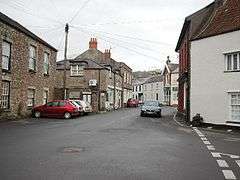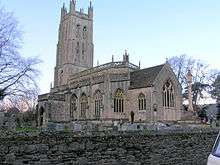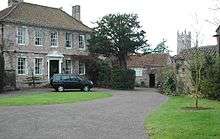Wrington
| Wrington | |
 Wrington High Street |
|
 Wrington |
|
| Population | 2,633 [1] |
|---|---|
| OS grid reference | ST470628 |
| Unitary authority | North Somerset |
| Ceremonial county | Somerset |
| Region | South West |
| Country | England |
| Sovereign state | United Kingdom |
| Post town | BRISTOL |
| Postcode district | BS40 |
| Dialling code | 01934 |
| Police | Avon and Somerset |
| Fire | Avon |
| Ambulance | South Western |
| EU Parliament | South West England |
| UK Parliament | North Somerset |
Coordinates: 51°21′42″N 2°45′38″W / 51.3617°N 2.7606°W
Wrington is a village and both a civil and an ecclesiastical parish in North Somerset, England. It lies in the valley of the Congresbury Yeo river, about 9 miles (14 km) east of Weston-super-Mare and 3 miles (4.8 km) south-east of Yatton. It has a population of 2,633.[1] Both parishes include the nearby village of Redhill.
History
The village dates back to Roman times and there is strong evidence of Saxon occupation.[2]
Wrington was part of the hundred of Brent-cum-Wrington.[3]

Wrington cottage hospital opened in 1864 and had 24 patients admitted in its first year of operation.[4] The first surgeon was Horace Swete who wrote the Habdy Book of Cottage Hositals.[5] It was also referred to by Florence Nightingale in 1869.[6]
Governance
The parish council has responsibility for local issues, including setting an annual precept (local rate) to cover the council's operating costs and producing annual accounts for public scrutiny. The parish council's role includes initiating projects for the maintenance and repair of parish facilities.[7]
The parish falls within the unitary authority of North Somerset which was created in 1996, as established by the Local Government Act 1992. North Somerset's area covers part of the ceremonial county of Somerset but it is administered independently of the non-metropolitan county. Its administrative headquarters is in the town hall in Weston-super-Mare. Between 1 April 1974 and 1 April 1996, it was the Woodspring district of the county of Avon.[8] Before 1974 the parish was part of the Axbridge Rural District.[9]
An electoral ward exists with the same name. The ward includes Butcombe in addition to the area covered by the parish. The total ward population taken at the 2011 census was 2,851.[10]
The parish is represented in the House of Commons as part of the North Somerset county constituency which was created from the Woodspring constituency for the 2010 General Election. It is also part of the South West England constituency of the European Parliament which elects seven MEPs using the d'Hondt method of party-list proportional representation.
Church


The church of All Saints has 13th-century foundations, and was remodelled with the addition of a west tower around 1450; it was restored in 1859 with further restoration to the tower in 1948. It includes stone busts to John Locke and Hannah More dating from the early 19th century on either side of the door. The chancel has Gothic reredos by Charles Barry dating from 1832. The rood screen is from the 16th century. It has a tall four-stage tower with set-back buttresses which develop into crocketted pinnacles at the top stage. The top displays moulded string courses and a trefoil pierced triangular parapet with gargoyles and corner pinnacles. It is Grade I listed.[11] According to Freeman it is "one of the "highest achievements of architectural genius".[12] Wickham it dates from the period 1420 to 1450.[13] The belfry stair is in the south-east turret. The height of the tower is 113.5 feet (35 m) to the top of the pinnacles.[14]
The 17th-century rectory is Grade II listed.[15]
The church's bells ring automatically. Until 2012, this took place every 15 minutes, including throughout the night. However, following the serving of a noise abatement order, the church has now had to reduce the frequency, and the bells now chime hourly during the night instead.[16][17]
Primary school

The village primary school was opened on 1 May 1857 [18] and is Grade II listed.[19]
Butcombe Brewery
A major institution in the local economy is the Butcombe Brewery, a microbrewery set up in the nearby village of Butcombe in 1978 by Simon Whitmore, the managing director of Courage Western, made redundant in a restructuring, and his wife Maureen. In 2003 the business was sold to Guy Newell and Paul Horsley, and moved to an industrial estate at Wrington,[20] to be housed in a purpose-built brewery completed in March 2005; in the same year the brewery set up a joint venture with Thatcher's, the Long Ashton Cider Company, producing a keg cider. In 2008 production was 24,000 barrels a year and direct outlet numbers were about 450.[21]
Notable residents
In birth order:
- Samuel Crooke (1575–1649), noted preacher and supporter of the Parliamentary cause in the English Civil War, was rector of Wrington for almost 50 years.[22]
- Robert Carr, 1st Earl of Somerset (c. 1585/6–1645), politician and courtier.[23]
- Francis Roberts (1607–1675), Puritan, librarian, scholar, and rector of Wrington from 1650 until his death.[24]
- John Locke (1632–1704), philosopher, was born in Wrington.[25]
- John Rogers (1679–1729), controversialist and cleric, rector of Wrington.[26]
- Samuel Wathen (c. 1720–1787), physician to Charlotte, wife of George III, died in Wrington.[27]"
- Henry Walton Smith (1738–1792), bookseller and newsagent, founder of the business that became W. H. Smith, was brought up in Wrington.[28]
- Hannah More (1745–1833), who worked to improve the conditions of miners and agricultural workers on the Mendip Hills, bought a house in the hamlet of Paradise, near Cowslip Green, where she lived with her sister, Martha, until 1828. She spent the last five years of her life in Clifton. She is buried at All Saints' church.[29] The More family tomb is a Grade II listed building.[30]
- Samuel Budgett (1794–1851), wholesale grocer, Wesleyan Methodist, philanthropist, and subject of a bestselling biography, was born in Wrington.[31]
- William Talbot Aveline (1822–1903), geologist and archaeologist, was brought up in Wrington.[32]
- George Howell (5 October 1833 – 16 September 1911), a prominent British trade unionist and reform campaigner in the 19th century, was born in Wrington.[33]
- Dame Mary Wills (c. 1861–1931) resided at Wrington.[34] She was knighted for her philanthropy.
- Walford Davies (1869–1941), composer, Master of the King's Musick, died at Wrington.[35]
- John Pilkington Hudson (1910–2007), the horticultural scientist and bomb disposal expert, retired to the Spinney, Ladywell, Wrington, where he and his wife created a notable garden.[36]
Football Club
Wrington Redhill AFC plays at the recreation ground in Wrington. The club operates a 1st team, a reserve team and an A team. The 1st team plays in the Erra Somerset County League in the premier division. The reserve team plays in Weston super Mare and District League Division 1 and A team in the W&D division 4. The club badge is a gold rampant dragon (wyvern), the same as the emblem on the unofficial Flag of Somerset. The club colours are green and black.
Wrington Cricket Club
Wrington currently has 2 senior teams. The 1st XI, is currently in the North Somerset Cricket League Saturday Division 1. The 2nd XI, is in Saturday Division 3. The club's limited overs team also finished as runners-up in the league's Butcombe Brewery KO Cup. The club also has a youth system, running teams in the North Somerset Youth Cricket Leagues at Under 17, 15, 13 and 11 levels. The clubs facilities have been improved in the last few years, and alongside an improved pitch, the club now has 2 nets, used for training sessions for all ages and levels.
References
- 1 2 "2011 Census Profile" (Excel). North Somerset Council. Retrieved 4 January 2014.
- ↑ "Roman Wrington". Wrington Website. Retrieved 26 February 2007.
- ↑ "Militia in the Brent-cum-Wrington Hundred". Wrington Somerset. Retrieved 12 September 2011.
- ↑ "Wrington village hospital". Wrington Village Records Studies of the history of a Somerset Village. Wrington. Retrieved 21 January 2015.
- ↑ Swete, Horace (1987). Handy Book of Cottage Hospitals. Hamilton, Adams and Co.
- ↑ Nightiongale, Florence (2012). McDonald, Lynn, ed. Florence Nightingale and Hospital Reform: Collected Works of Florence Nightingale, volume 16. Wilfrid Laurier Univ. Press. ISBN 9780889204713.
- ↑ "Local Environment". Wrington Parish Council. Retrieved 2 July 2014.
- ↑ "The Avon (Structural Change) Order 1995". HMSO. Retrieved 9 December 2007.
- ↑ "Axbridge RD". A vision of Britain Through Time. University of Portsmouth. Retrieved 4 January 2014.
- ↑ "Ward population 2011.Retrieved 10 March 2015".
- ↑ "Church of All Saints". Images of England. Retrieved 26 February 2007.
- ↑ Brereton, R. P (1904). "Somerset Church Towers". The Archaeological Journal. Somersetshire Archaeological Society at Gillingham. lxii. 60 collotypes prepared for a planned monograph are in the British Museum, Add. MSS. 37260-3, were published by the Society.
- ↑ Wickham, Archdale Kenneth (1965). Churches of Somerset. London: David & Charles.
- ↑ "Description of the church". All Saints Wrington. Retrieved 5 March 2008.
- ↑ "The Old Rectory". Images of England. Retrieved 26 February 2007.
- ↑ Wrington All Saints Church clock silenced in noise row, BBC News, 25 April 2012
- ↑ Somerset church bell to ring again after agreement reached, BBC News, 2 December 2012
- ↑ Wrington's Victorian Schools, Mark Bullen 2012
- ↑ "Wrington Primary School". Images of England. Retrieved 26 February 2007.
- ↑ "Timeline". Butcombe Brewery. Retrieved 30 September 2008.
- ↑ Pints West, No. 79. Autumn 2008, Campaign for Real Ale, Bristol, p. 12
- ↑ Hunt, William Samuel Crooke Dictionary of National Biography 1885–1900 Vol. 13, p. 205.
- ↑ Alastair Bellany, "Carr , Robert, earl of Somerset (1585/6?–1645)", Oxford Dictionary of National Biography (Oxford: OUP, 2004) Retrieved 2 July 2014. Pay-walled.
- ↑ Nicholas Keene, "Roberts, Francis (1609–1675)", Oxford Dictionary of National Biography (Oxford, OUP 2004) Retrieved 2 July 2014. Pay-walled
- ↑ "John Locke". Encyclopedia of Philosophy. UC San Diego. Retrieved 27 April 2010.
- ↑ "Rogers, John (1679–1729)". Dictionary of National Biography (London: Smith, Elder & Co., 1885–1900).
- ↑ Journal of the History of Medicine and Allied Sciences (Yale University, Department of the History of Science and Medicine, Vol. 5, 1950, p. 299.
- ↑ W. H. Smith history site. Retrieved 2 July 2014.
- ↑ Toulson, Shirley (1984). The Mendip Hills: A Threatened Landscape. London: Victor Gollancz. ISBN 0-575-03453-X.
- ↑ "More Family Monument in churchyard". Images of England. Retrieved 26 February 2007.
- ↑ William Arthur: The Successful Merchant (London, 1852).
- ↑ J. Boycott and L. J. Wilson: The Aveline Brothers at Aveline's Hole. Proc. Univ. Bristol Spelaeol. Soc." 201210, 25 (3), 302–312. Retrieved 2 July 2014.
- ↑ "Howell, George (1833–1910) politician and writer". Bishopsgate Institute. Retrieved 27 April 2010.
- ↑ "Henry Herbert Wills". The Thompsons, Shipbuilders of Sunderland. Retrieved 13 November 2010.
- ↑ Jeremy Dibble, "Davies, Sir (Henry) Walford (1869–1941)". Oxford Dictionary of National Biography (Oxford: OUP, 2004) Retrieved 3 July 2014. Pay-walled.
- ↑ ODNB entry Retrieved 24 July 2011. Subscription required.
External links
| Wikimedia Commons has media related to Wrington. |